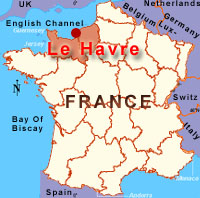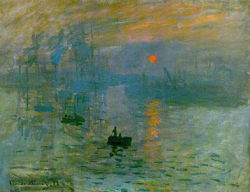Venue
Conference place:
Le Havre, Normandie, France
(2 hours from Paris by train)
Normandie University - Le Havre
UFR Sciences et Techniques (Room Lesueur)
25 rue Philippe Lebon, 76600 Le Havre
( -->The university is in 6mn of walking of the railway station)
|
|

|
|
The history of the city is inextricably linked to its harbour. In the 18th century, as trade from the West Indies was added to that of France and Europe, Le Havre began to grow. During the 19th century, it became an industrial centre, an image vividly brought to life by the paintings of Claude Monet. The German-seized city was devastated during the Battle of Normandy in World War II: 5,000 people were killed and 12,000 homes were totally destroyed, mainly by British air attacks. Despite this, Le Havre became the location of one of the biggest Replacement Depots, or "Repple Depples" in the European Theatre of operations in WWII. Thousands of American replacement troops poured through the city before being deployed to combat operations. After the war, the center was rebuilt in modernist style by Auguste Perret. |
|
UNESCO declared the city center of Le Havre
a World Heritage Site on July 15, 2005,
in honoring the "innovative utilization of concrete's potential."
The 133-hectare space that represents, according to UNESCO,
"an exceptional example of architecture and town planning of the post-war era,"
is one of the rare contemporary World Heritage Sites in Europe. |

|

|
Useful Links
- Interesting new website about Le Havre
- Le Havre Weather
- Le Havre Tourism
- Le Havre
- Le Havre Ville
- LD Lines Ferries to Le Havre
- Some impressions of Le Havre by Cyrille Bertelle
- UNESCO I
- UNESCO II
- MUMA - Musee Malraux
Conference Venue

|
The WANCSA 2017 workshop is organized in |
Map, from the railway station to the university
Enlarge the map

 Le Havre is a city in the northwest region of France (200 Kms away from Paris,
and 2hours by train) situated on the right bank
of the mouth of the Seine River, in the southwest of the Pays de Caux region.
It is a commune in the Seine-Maritime department and the Normandie region.
The inhabitants of the city are called Havrais or Havraises.
It is the most populous commune in the Normandie region and the
largest sub-prefecture in France. The city is surrounded by the seashore
of the English Channel to the west, the mouth of the Seine to the south,
and the coast to the north. The Seine has, for a long time, marked a natural
border between Haute-Normandie and Basse-Normandie.
Thus, the city of Honfleur is, in the expression of the Havrais, "on the other coast."
Le Havre is a city in the northwest region of France (200 Kms away from Paris,
and 2hours by train) situated on the right bank
of the mouth of the Seine River, in the southwest of the Pays de Caux region.
It is a commune in the Seine-Maritime department and the Normandie region.
The inhabitants of the city are called Havrais or Havraises.
It is the most populous commune in the Normandie region and the
largest sub-prefecture in France. The city is surrounded by the seashore
of the English Channel to the west, the mouth of the Seine to the south,
and the coast to the north. The Seine has, for a long time, marked a natural
border between Haute-Normandie and Basse-Normandie.
Thus, the city of Honfleur is, in the expression of the Havrais, "on the other coast."